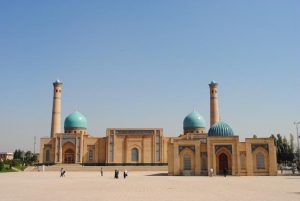“Khiva is a jewel of Orient, a man made wondering city!”
Khorezm is situated in the lower reaches of Amudarya River between the boundless Kizil Kum and Kara Kum deserts.Khorezm is the native land of ancient civilization and where was born foreword of “Avesto”(sacred book of Zoroastrism).From the 10th c. Khorezm became a large economic,cultural and scientific centre.Here great scientists,astronomers,mathematicians,such as Al-Khorezmi(who invented “0”and who is known now in Europe as “Algoritmus”)and Biruni(who put forward the theory about the Earth, is round and it turns around its axe)lived and worked.Here in 11th c. the first Academy of Science in the East was found(Mamun`s Academy). Khiva – one of the most ancient cities in the world,was evidence of the rise and fall of Khorezm.The final appearance of old Khiva was formed at the end of 17th and at the beginning of the 19th c.c.Khiva,whice consists of two parts:Ichan Kala(Inner Fortress) and Dishan Kala(Outer Fortress).And 2 palaces,more than 60 madrassahs and mosques,mausoleums,caravan-serai,bath-house and etc. are situated in Ichan Kala as well.That`s why Ichan Kala is called “An open air museum” and all the historical monuments are included in 1990 into the Heritage List of UNESCO.In 1997 Khiva celebrated its 2500 year old anniversary.
Khiva has existed for a long time as a transcontinental pit-stop from Gurgani to Merv. Unlike to the other ancient cities of Asia, the historic heart of it is so well preserved that sometimes it seems that life has been almost squeezed out of it. Walking around the remarkable places of Ichan-Kala, you will notice the magnificent simplicity and monumentality of medieval architecture, and watch the delicate wood carving and skilled interweaving of ornamentation. The tall and beautiful silhouettes of towering minarets, hemmed in by clay houses with flat roofs and surrounded by the strong clay walls of a powerful fortress will give you a nice and clear idea of a typical feudal city in Central Asia.
Actually, Khiva is being the leader among the ancient Central Asian cites in the number of fascinating minarets. It is really made up of madrassahs, mosques and minarets.

